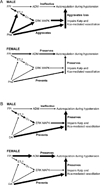Cerebral Blood Flow Autoregulation and Dysautoregulation
- PMID: 27521192
- PMCID: PMC4988341
- DOI: 10.1016/j.anclin.2016.04.002
Cerebral Blood Flow Autoregulation and Dysautoregulation
Abstract
This article provides a review of cerebral autoregulation, particularly as it relates to the clinician scientist experienced in neuroscience in anesthesia and critical care. Topics covered are biological mechanisms; methods used for assessment of autoregulation; effects of anesthetics; role in control of cerebral hemodynamics in health and disease; and emerging areas, such as role of age and sex in contribution to dysautoregulation. Emphasis is placed on bidirectional translational research wherein the clinical informs the study design of basic science studies, which, in turn, informs the clinical to result in development of improved therapies for treatment of central nervous system conditions.
Keywords: Anesthetics; Cerebral autoregulation; Cerebral blood flow; Traumatic brain injury.
Copyright © 2016 Elsevier Inc. All rights reserved.
Figures

References
-
- Lassen LA. Cerebral blood flow and oxygen consumption in man. Physiol Rev. 1959;39:183–238. - PubMed
-
- Drummond JC. The lower limit of autoregulation: time to revise our thinking? Anesthesiology. 1997;86:1431–1433. - PubMed
-
- Lassen LA. Control of cerebral circulation in health and disease. Circ Res. 1974;34:749–760. - PubMed
-
- Aaslid R, Lindegaard KF, Sorteberg W, Nornes H. Cerebral autoregulation dynamics in humans. Stroke. 1989;20:45–52. - PubMed
-
- Tiecks FP, Lam AM, Aaslid R, Newell DW. Comparison of static and dynamic cerebral autoregulation measurements. Stroke. 1995;26:1014–1019. - PubMed
Publication types
MeSH terms
Substances
Grants and funding
LinkOut - more resources
Full Text Sources
Other Literature Sources

